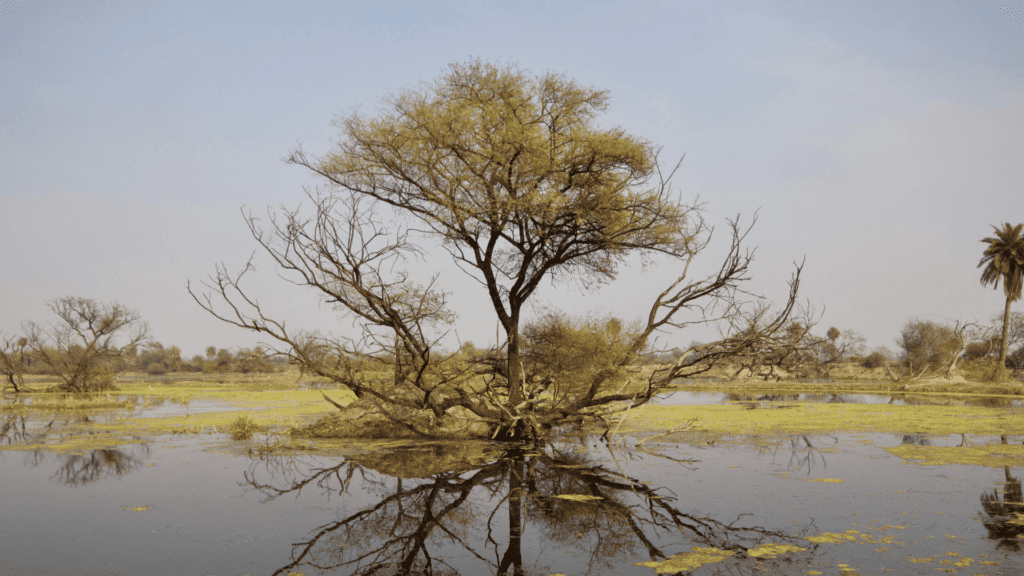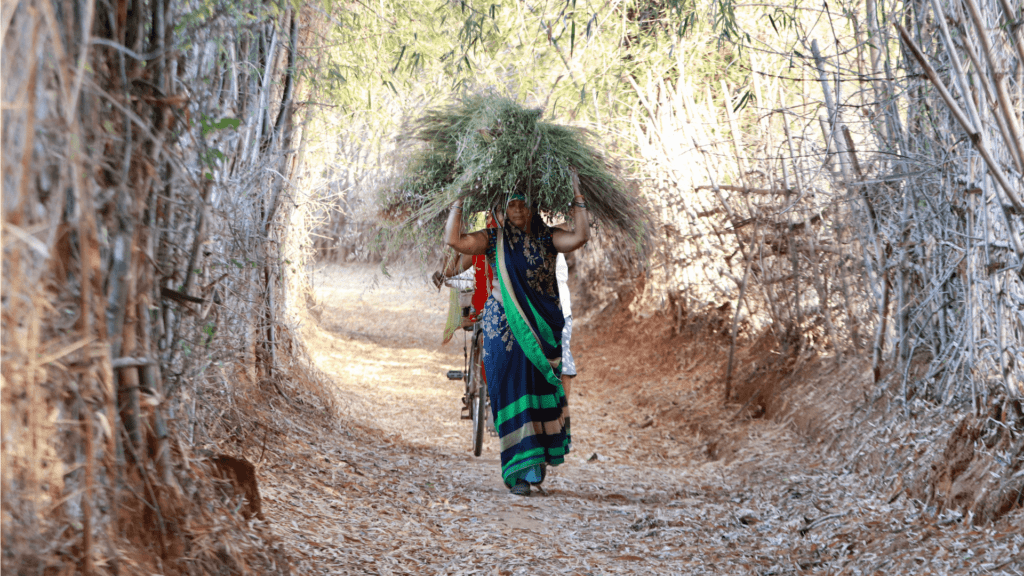A People’s History of Conservation in India
For 600 years women have been at the heart of peaceful environmental protest in India.
The Thar Desert stretches, like an undulating golden-grey quilt, across Rajasthan. Summers here are blindingly hot, with temperatures reaching 50°C in the shade, and winds laden with sand, swirling across the landscape. The towns are bustling hubs of tourism and commerce, but in the outskirts, there is little to catch the eye, save for a scrubby, dry horizon. Here and there, breaking the monotony, you may find the unassuming khejri tree. This small but sturdy evergreen tree has been at the heart of battles since the beginning of time. During the days of the Ramayana, Lord Rama worshipped this tree before he went into fateful battle with Ravana, king of Lanka. Since then, the tree has been worshipped by Rajput royalty, for its auspicious symbolism. But in 1730, on an aridly hot day in September, the khejri tree found its roots bloodied by a new kind of conflict.
Amrita Devi was a member of the Bishnoi community, native to Rajasthan. The Bishnois are followers of the 15th-century seer, Guru Jambheshwar, whose 29 commandments define the community’s way of living. The tenets are fairly simple, preaching good social behavior, personal hygiene, daily worship and the protection of animals and trees. Yet behind these simple rules lay a complex framework of coexistence and harmony, for the Bishnoi to practice a sustainable existence in an otherwise inhospitable climate. The khejri tree was the beating heart of that way of life. Not only did it provide invaluable shade, but its leaves were fodder for livestock, its pods were edible and its wood could be used for fuel. This last characteristic of the khejri tree was the most attractive for Abhay Singh, ruler of Jodhpur, on that September morning in 1730.
The king had decided to build a new palace for himself and needed wood to keep the massive kilns in Jodhpur firing. Abhay Singh had heard of the green groves of khejri that grew abundantly in a village called Khejarli, some 20 kilometers out of the city gates. He dispatched men to the village, with orders to cut down the trees and bring back supplies of wood. There was absolute uproar in Khejarli when the king’s men arrived. Cutting down – or otherwise harming – trees was against the dharma of the Bishnoi. An argument ensued and voices were raised.

On hearing the commotion, Amrita Devi rushed out of her house. Her curiosity soon transformed into shock. She launched herself at the nearest tree, hugging it desperately. If the men wanted to cut it down, she told them, they would have to take her with it. The story goes that the men didn’t hesitate, slicing cleanly through Amrita with their axes and hacking the tree down with her. Distraught, her three daughters – who had followed their mother out of the house –clasped nearby trees too. They were mowed down as well. By this time, word of the bloodshed in Khejarli had spread to over 80 Bishnoi villages. A hasty council of village elders produced one result: for every tree that would be cut down, one Bishnoi volunteer would sacrifice his or her life. In all, 363 Bishnois across 49 villages laid down their lives that day.
The implications of that act were resounding. Abhay Singh, overcome with remorse, issued a public apology and a decree, prohibiting the cutting of trees and hunting of animals within and near Bishnoi villages. That decree holds even today.
In pre-colonial times, actions like those of Amrita Devi were not sensational acts of sacrifice, but accepted practices, based on ideas of land ownership. These, for the most part, were based on communal ownership, an inherent respect for nature and the belief that humans were part of a larger ecosystem. In pre-colonial ecological Indian history, the emphasis was on man appreciating nature as a valuable entity, despite a more practical system for revenue and agriculture being in place.
Ecological Struggles in Post-Colonial India
Centuries have passed since Amrita Devi gave up her life for the khejri tree. India is home today to communities that are as diverse as they are independent of each other – from the tribes of the Andamans to the nomadic shepherds of Himachal Pradesh; from the textile mills in Coimbatore to the steel towns of Jamshedpur; from the toddy-tappers in Tamil Nadu to the pottery kilns of Rajasthan. Yet, modern India is also a society deeply riven by economic, social and political conflicts, most of which center around ecological resources.
Harsh Sethi, a lawyer and leading scholar on environmental issues, divides the environmental struggles in India into five categories:
- Forest based
- Land use based
- Against big dams
- Against industrial pollution
- Against the exploitation of marine resources
Post-independence, as constitutional and political reform took center stage, the environment barely figured into discussions on national progress. Even as Indira Gandhi was forming Project Tiger, to save the majestic animal from extinction, there was a greater push towards industrialization, towards the kind of progress that could be quantified in concrete terms.
Ecological struggles in post-colonial India have been those of the poor, the dispossessed, the marginalized and discriminated, and the landless.
Around the same time, the densely forested Terai region of Uttarakhand, nestled in the Himalayan foothills, had caught the eye of timber merchants. By early 1972, large-scale deforestation was scything through the hills, resulting in the loss of topsoil and, inevitably, landslides and floods. Women were devastated by the consequences of this brazen deforestation. It now took them twice as long to collect wood for fuel, fodder or water. The discontent in the region began in Chamoli, taking shape in the voices of Bachni Devi, Sudesha Devi and Gaura Devi. Each of these women shared similar stories – of resilience, of courage and of, despite a lack of formal education, an almost instinctive awareness of the impact of ecological imbalance of any kind.
In 1974, when contractors hired by a sports equipment organization from Allahabad came to the village of Raini to begin felling trees, Gaura Devi, accompanied by 26 other women, went into the woods late at night and faced down the company’s workers. Gaura called the trees her maika (mother’s home) and invited the loggers to shoot them instead of cutting the trees. Work was halted all night as the women hugged the trees, despite a hail of abuse and threats. Over the next few days, more villagers joined the protest.

Gaura Devi’s bravery inspired other movements across the environmentally sensitive region, finding echoes in the protests against the building of the Tehri Dam across the Tehri River in 1978. Sudesha Devi, who had been a leader of the Chipko Movement herself, went up against local police and contractors against the preservation of the Rampur Forest, and was jailed for three weeks for her stand. In the 1980s, Chipko activists protested limestone mining in the Doon Valley, leading to the banning of quarrying in the region and a vast public drive for afforestation.
Ecological struggles in post-colonial India have been those of the poor, the dispossessed, the marginalized and discriminated, and the landless. Most movements have also been around the conservation of natural resources to sustain livelihoods. The role of women, and rural women in particular, in modern-day fights cannot be underestimated. In rural India, women are responsible for sustenance and survival, for bringing in water, fuel, fodder and generally ensuring a functional hearth and home. They are keepers of biodiversity, taking on the burden of seeding, weeding and harvesting. For them, the impact of deforestation and the need to conserve water and other resources is far higher. Small wonder, then, that Amrita Devi’s sacrifices found an echo in women’s struggles in modern India, particularly in the Chipko Movement of the 1970s.

Echoes of the Chipko movement in Modern India
The Chipko Movement opened the floodgates for women’s participation in conservation in modern India. There were many ways in which women could and did participate, and each of 3 these methods relied on non-violence – from hugging trees to wielding their pens in protest. In 1976, an article written by the environmental activist, Prof. M.K. Prasad drew attention to one of the most endangered yet least studied habitats on earth: the Silent Valley in the district of Palakkad in Kerala. The central government wanted to build a 120 MW hydroelectric project amidst the greenery of the Valley. A committed conservationist and a secret poetess, Sugathakumari lost no time in bringing together a small group of activists and scientists who shared her concerns for the fate of Silent Valley. Her poem, Marathinu Stuti (Ode to a Tree) became the anthem for the movement to save the Silent Valley. As a result, the Forest Conservation Ordinance was passed in 1980, which stipulated that nonforestry on forest lands couldn’t be rerouted without the prior approval of the central government. In 1983, the Government of India abandoned the hydel project altogether, in order to conserve the Valley.
In the Uttara Kannada region of Karnataka, the Appiko Movement saw women coming out to protest the widespread devastation caused by major industries like pulp and paper mills and hydel projects in the area. The immense damage was leading to the submersion of huge swathes of forest and agricultural areas and a sharp shrinkage in forest cover. A massive padyatra was undertaken across the Western Ghats, from Karnataka to Goa, to raise awareness about the evils of deforestation.
Then, there was the Narmada Bachao Andolan, a movement that gained immense publicity under the leadership of Medha Patkar. The Andolan galvanized awareness of ecological disasters that could stem from projects aimed at development. Several more women have since become the faces of various major milestones in India’s ecological politics. Noted river activist Latha Anantha, who passed away in 2017 after battling a prolonged illness, fought spiritedly for the restoration of natural river flows, including against the construction of the dam on the Chalakudi River.
Then, there are those who continue to fight quietly, like Nizara Phukan, the 31-year-old PhD student from Jawaharlal Nehru University, who embarked on a padyatra from her native home in Sivasagar to New Delhi in 2019, in order to raise awareness about the impact of climate change. Then, there is Saalumarada Thimmakka, the woman who planted and nurtured over 380 banyan trees in a single stretch of four kilometers on a barren highway between Hulikal and Kudur in her native state of Karnataka. The story goes that these banyan trees were, for Saalumarada, like her own little children – for she was unable to have any of her own.

But in all these cases, women tended to underscore the point that violence is not required to effect immediate change. It is a quiet list, but it is all the more powerful because of the wide spectrum of women, across class, caste and community, involved in the fight to protect the environment. Seen from a historical lens, then, it is clear that environmental fissures are as deeply gendered as political or social fissures, even in the 21st century.
That is why even though women’s interactions with nature and their responses to environmental devastation must be seen within the parameters of labor, power and ownership of property, it must equally be recognized that women are not merely victims of an unequal socio-economic matrix. They are key agents of change, whether rural or urban. In order to reframe the struggles of women – from Amrita Devi to Medha Patkar and from Gaura Devi to the more recent example of Dr. Purnima Devi Barman, fighting to save the Greater Adjutant Stork from extinction in Assam – in trying to protect the environment, there must be a shift in perception, from treating women as objects of policy to recognizing their capacity to catalyze change. Only then can women truly emerge from the shadows of India’s complex conservation politics.
